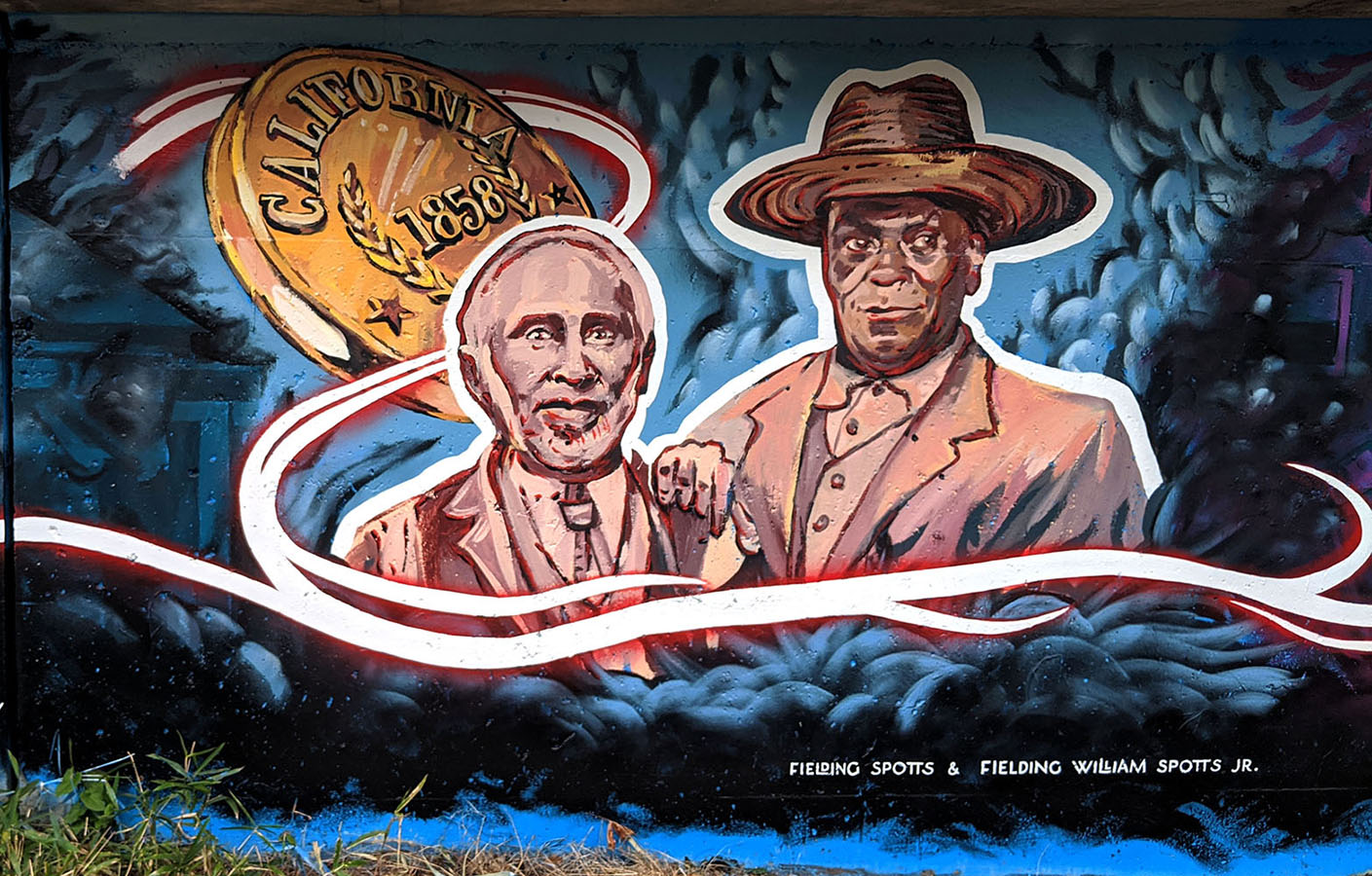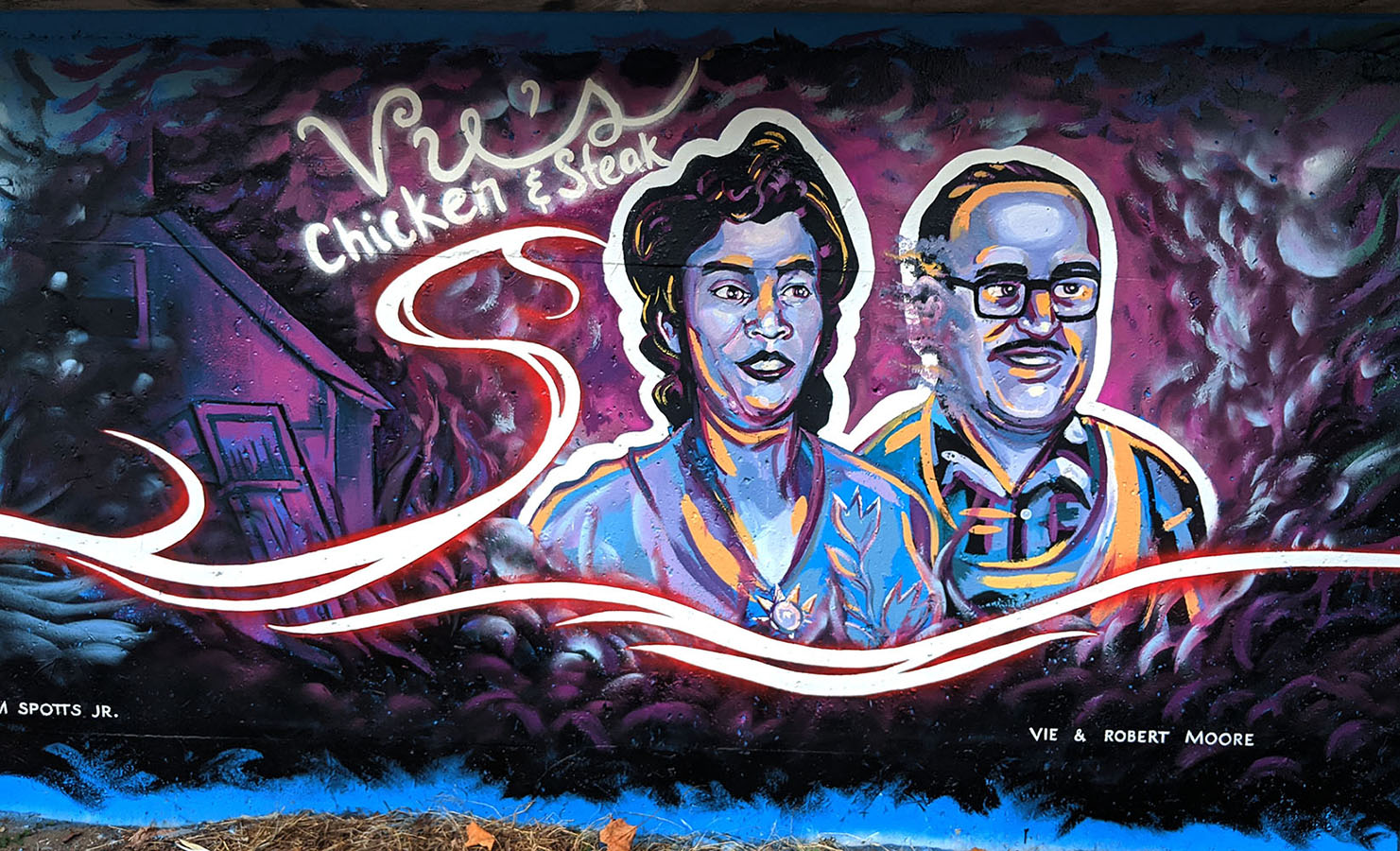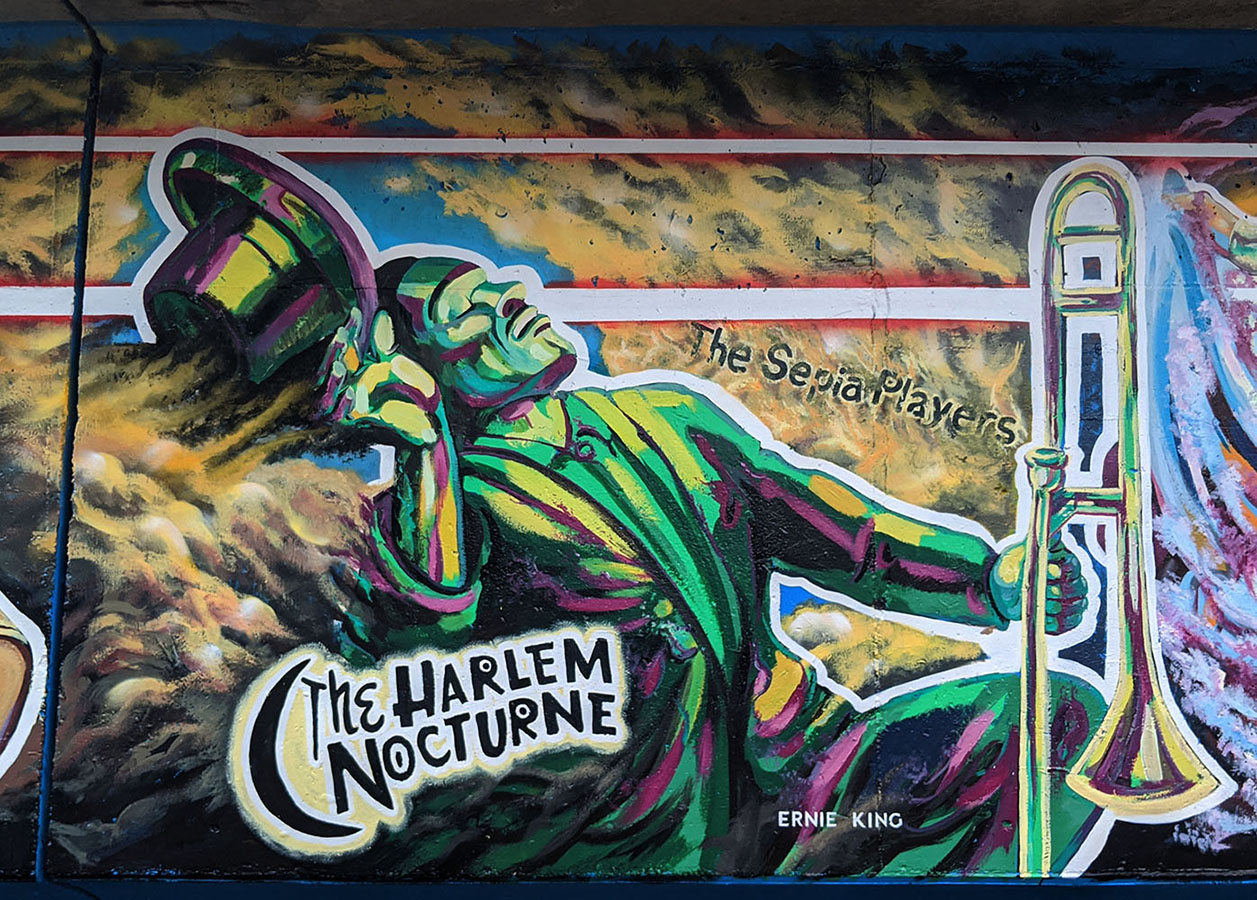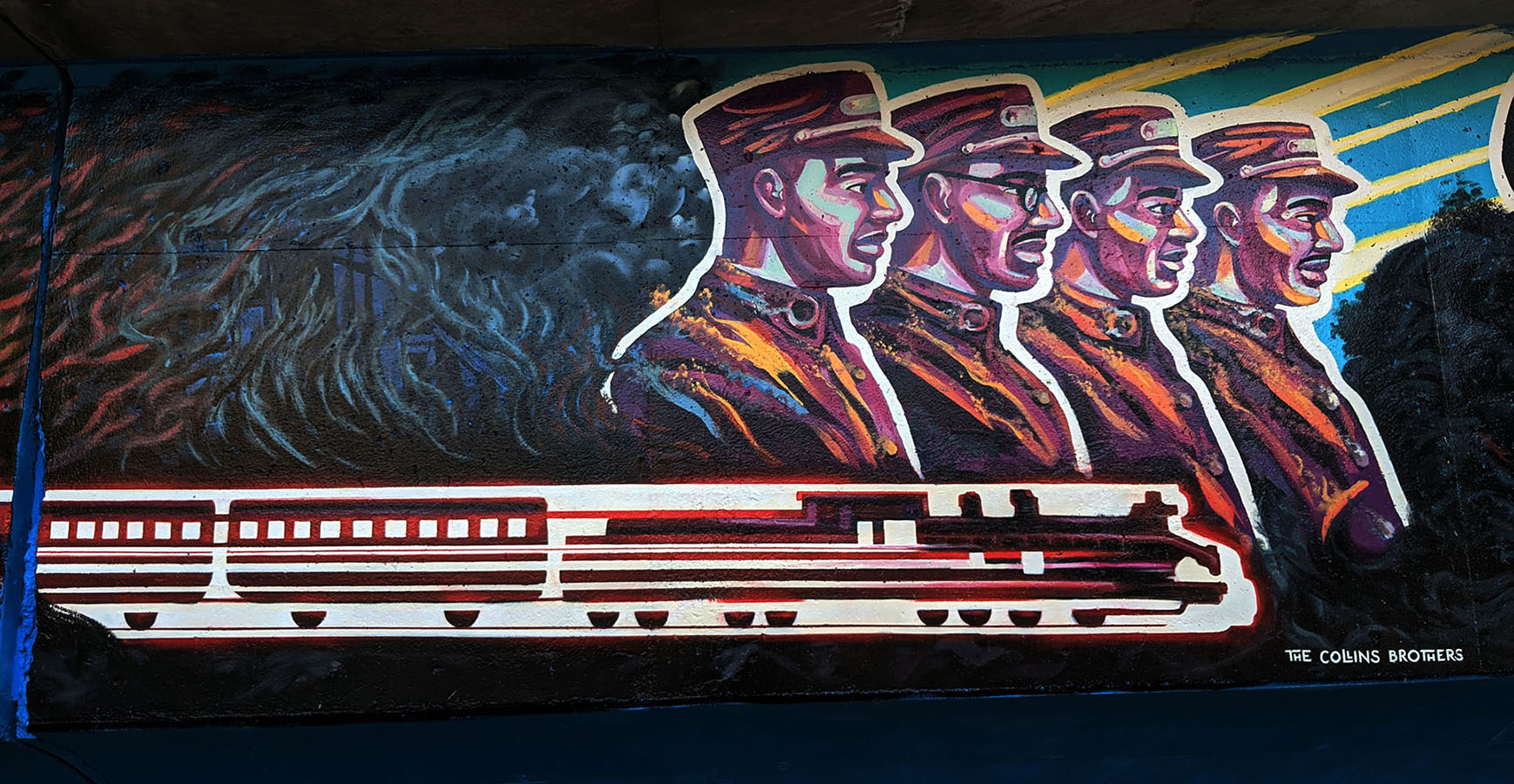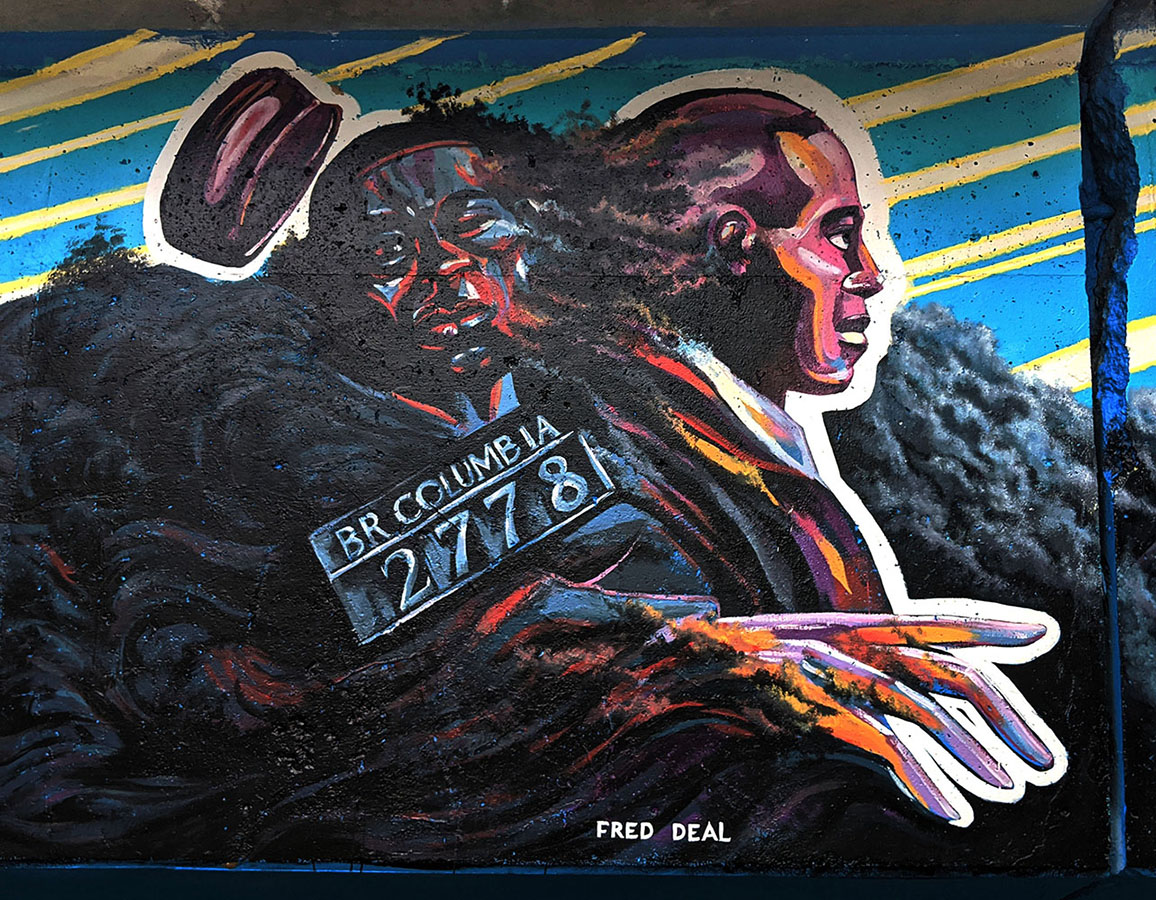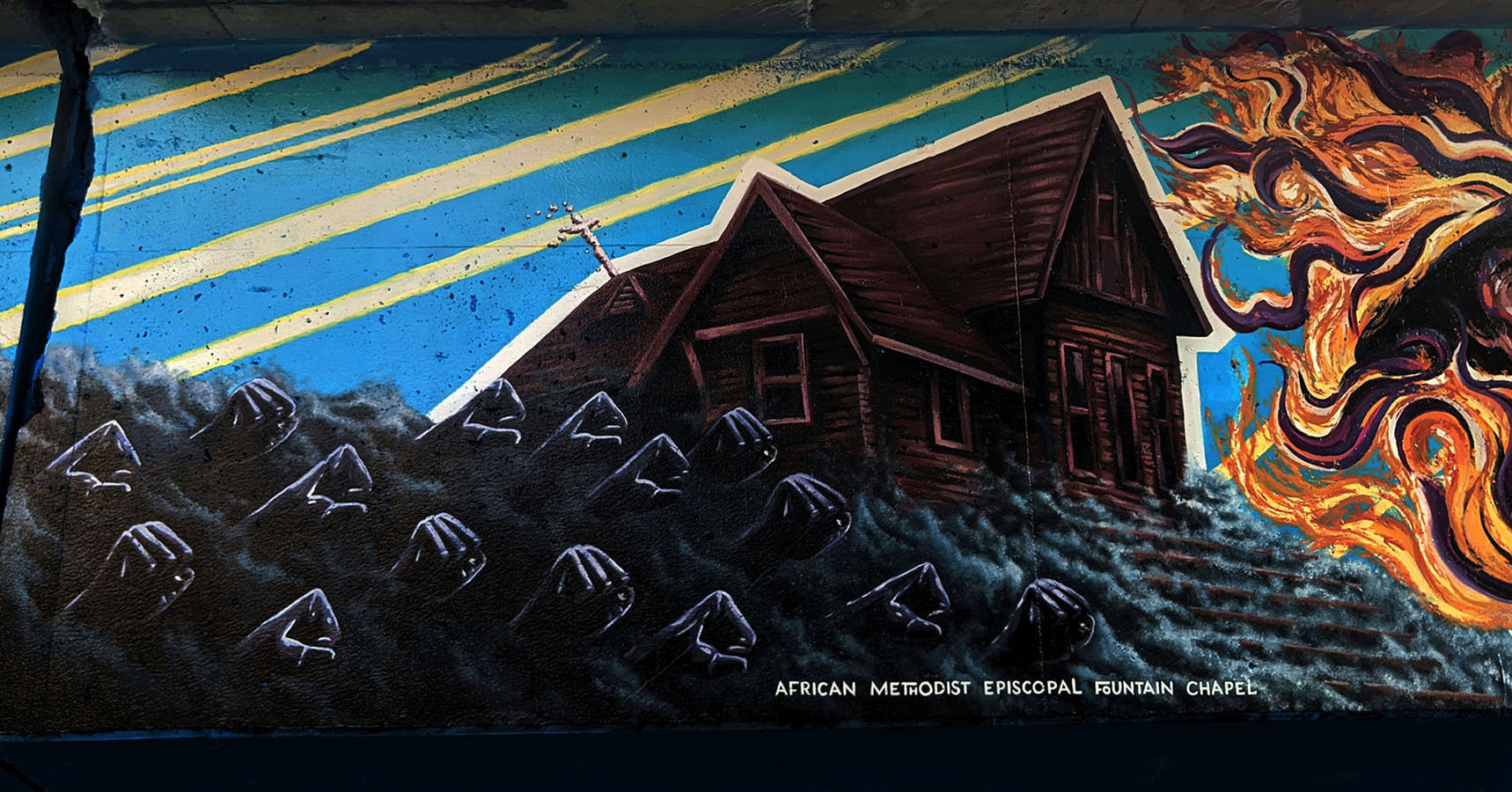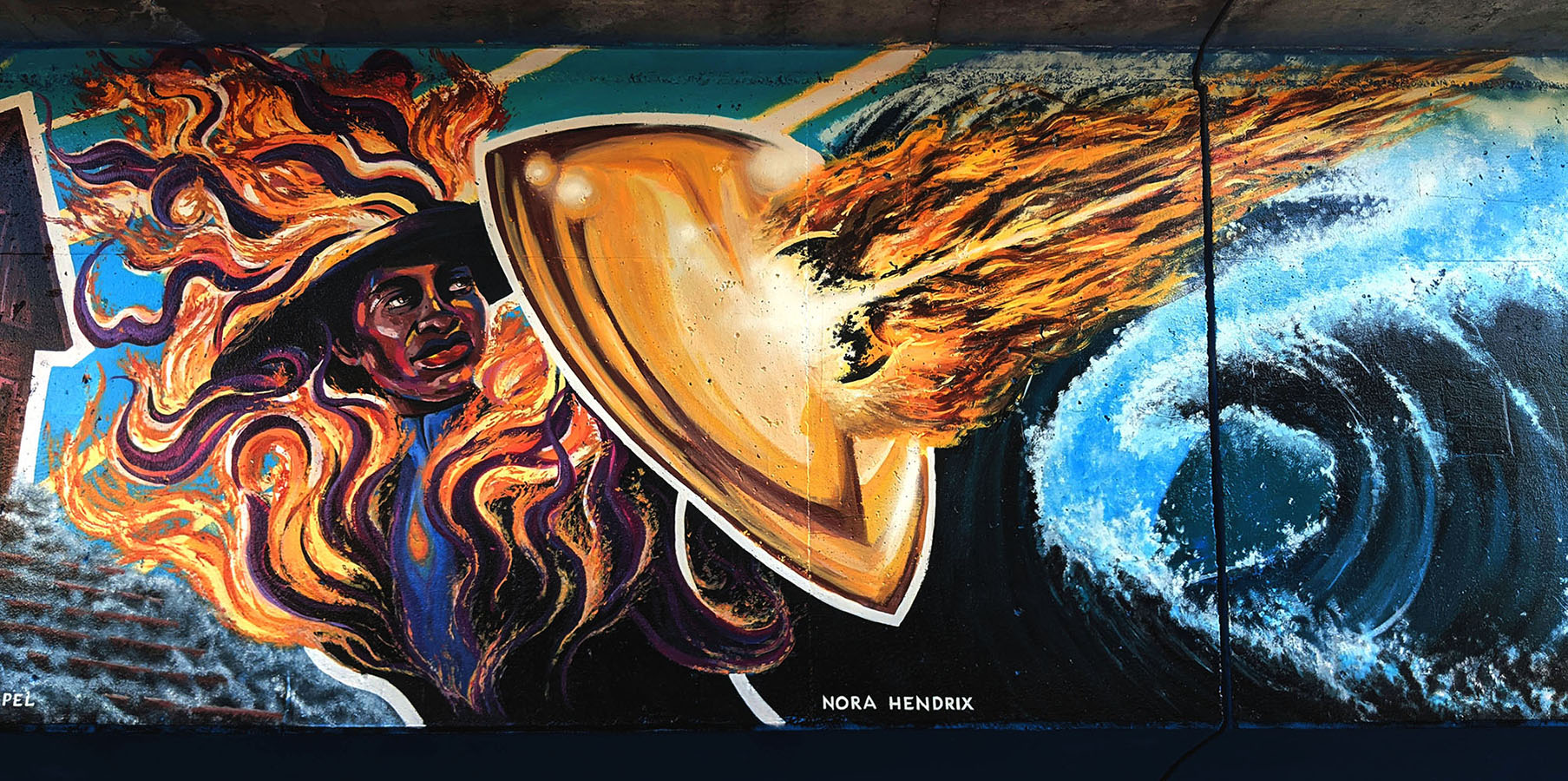DATE
2020
Organization
MEDIUM
Latex paint, Aerosol
In March of 2020, I was selected as one of the artist to take part in the 2020 Vancouver Mural Festival – an annual summer festival in Vancouver where select artists create public murals around the city. During each year of the festival, a community project is curated in which a mural is painted to both reflect and support a Vancouver community its cultural impact. I was given the honour to create the mural for this year community project which focused on Hogan’s Alley, a former neighbourhood within the Strathcona district of Vancouver which was home to Vancouver’s first and only concentrated black community.
“The neighbourhood was a popular cultural hub before mid-twentieth century urban renewal schemes and the Georgia Viaduct Replacement Project demolished many of its buildings.”
– excerpt from comparative plaque located on union street in the alley east of Main Street
Upon being given the opportunity to paint a mural about Hogan’s Alley on the Georgia Viaduct, it was hard for me not to think about the fact that I was adding art to the very instrument that led to the destruction of Vancouver’s first concentrated black community. While I was originally only going to mildly touch on the destruction of Hogan’s Alley for the purpose of the viaduct, I now found myself taking a more somber tone in my approach to the mural design by placing the majority of the painting within the setting of rising ashes from the neighborhood’s demolition.
It was only when learning of the history of the black community within Hogan’s Alley that I am refilled with uplifting feelings. No better example of resilience could be expressed than by visualizing these former residents, their legacies rising like hope through the ashes.
Hogan’s Alley embodied hope for a thriving united black community in BC, enjoyed by all walks of life. In destroying Hogan’s Alley, the city of Vancouver destroyed a black community but not black culture as it continues to flourish in a diaspora within Vancouver’s cultural fabric.
Time will tell if the ongoing evolution of black culture within Vancouver can bring another community to fruition.
MURAL SECTIONS
YELLOW KID
Within the deepest depth of the ashes, Yellow Kid lies dead. A prominent character from the New York comic strip entitled Hogan’s Alley, Yellow Kid was very much a mascot of this early 19th-century strip from which the name for the Hogan’s Alley area was significantly influenced and derived. As Yellow Kid’s peculiar dialogue would be written on his oversized shirt, serving as a punchline, the origin of his name comes from the term ‘yellow journalism’ referring to tabloid and sensationalized journalism. The comic strip dealt with a rowdy New York City working class neighborhood described as “… a turn-of-the-century theater of the city, in which class and racial tensions of the new urban, consumerist environment were acted out by a mischievous group of New York kids from the wrong side of the tracks”. While Hogan’s Alley became a name that was embraced and commonly used to refer to the now demolished southwestern edge of the Strathcona neighborhood in Vancouver, it was not originally used with flattering intent but rather as a tongue in cheek reference. As such this influence resonates with a minstrel show feel, making the death of Yellow Kid represent the death of the tokenism of Hogan’s Alley, dissipating attempts at making a novelty out of the black community that resided there.
A rose grows next to Yellow Kid. As the official flower of Vancouver, the rose symbolizes the spirit of Vancouver continuing to bloom. The spirit of the black community shines as a light of hope, expanding out and around the rose before streaking through the smoke and ashes of its physical demolition.
FIELDING SPOTTS & FIELDING WILLIAM SPOTTS JR.
As the light expands through the smoke, a California gold coin shines as a symbol of African Americans who sailed from California in 1858 to settle in British Columbia.
Rising smoke takes on a brighter hue as Fielding Spotts appears. One of the earliest settlers in BC by way of the Californian migration, Spotts first resided in Victoria. At his side is his son Fielding William Spotts Jr. who would later move to Hogan’s Alley, residing there as one of last original pioneers.
VIE & ROBERT MOORE
Smoke continues to rise and change in color, revealing Vie and Robert Moore, owners of the famous spot Vie’s Chicken and Steaks. Hogan’s alley was known for its “chicken house” restaurants, which often doubled as speakeasies, and from the 1940’s to the 1970’s the Moore’s ran the most well-known soul food establishment in Vancouver. From late afternoon until the wee hours of the morning, Vie’s would draw in all walks of life, including entertainers such as Louis Armstrong, Lena Horne and Sammy Davis Jr, all of whom would come to wine and dine after shows.
LEONARD LANE
Next to appear is Leonard Lane. An active member of the Hogan’s Alley community, Leonard Lane first became politicized when he was refused service in local restaurants. Lane became a fulltime member of the British Columbia Association for the Advancement of Colored People, and became involved in civil rights. Lane took on the Minister of Education over the use of racist language in schoolbooks, worked on housing issues, and wrongful dismissals and discrimination in the workplace.
Leonard Lane was also one of the original members of the Unity Credit Union; providing loans in the 1960’s to younger members of the Black community looking to buy their first homes. Lane was treasurer for eight of the twelve years that the credit union operated, before it became part of the main branch of the Vancity Credit Union.
BARBARA HOWARD
Sprinting along the light and across the ashes is Barbara Howard. While still in grade 11, Howard became the first black female athlete to represent Canada in international competition at the 1938 British Empire Games in Australia.
Competing in the 100-yard race, Barbara’s qualifying time beat the Games’ record, but at the Games themselves she ended up finishing 6th. Nonetheless, Howard also won silver in the 440-yard race and bronze in the 660-yard relay. Howard had hoped for gold at the 1940 Olympics in Tokyo, but the Games were cancelled due to World War II, as were the Games in 1944.
Barbara Howard then turned her focus to education and became the first visible minority to be hired as an educator by the Vancouver School Board in 1948. Howard then went on to have a 43-year career in education, which included teaching in the Strathcona neighborhood which encompassed Hogan’s Alley.
THE CRUMP TWINS
Bursting through the smoke with rhythm are Ronnie and Robert Crump, famously known as the Crump Twins. From an early age they became two of the most recognizable performers in Vancouver, playing the local and national music scene with an act that included singing, tap dancing, and comedy. With Ronnie on the drums and Robert on the guitar, the Crump twins even played alongside musical legends such as Louis Armstrong, and even a young Jimi Hendrix as their families grew up together in Hogan’s Alley.
With a musical career that spanned throughout the 1940’s, 50’s, and 60’s, the Crump twins’ contributions to the early years of Vancouver’s entertainment scene earned them an induction into the BC Entertainment Hall of Fame in 2019.
ERNIE KING
Ernie King then appears posing with a flair all his own. After serving in the World War II where he learned to play trombone, Ernie King started the jazz band Five Guys Named Moe. After failing to book regular gigs at local venues, King purchased a building in Strathcona and opened the Harlem Nocturne, Vancouver’s only Black-owned and operated nightclub. A little over a decade later, King founded the city’s first black theatre company The Sepia Players, giving many black performers opportunities that they could not find elsewhere in Vancouver.
Never one to wait for others to bring him opportunities, Ernie King lived by the motto that “There’s nothing in the world you cannot do.”
THE GIBSON’S
Leaping and dancing across the ashes and through the smoke are legendary entertainers from the iconic Gibson family. The Gibson siblings grew up in Hogan’s Alley where they were raised by Leona Risby and Jim Gibson.
First is Thelma Gibson, an accomplished singer, dancer and actor. Thelma toured internationally and worked in nightclubs across Canada, the West Indies and Africa, before being given a lifetime achievement award from the Black Historical and Cultural Society of BC in 2005.
Alongside Thelma is Leonard Gibson, oldest of the Gibson siblings, and an award-winning dancer, choreographer and teacher. Leonard formed the Negro Workshop Dance Group, which eventually led to work with Ballet BC. In 1954 Leonard choreographed “Bamboula”, the first musical variety tv series produced by CBC Vancouver, showcasing Caribbean music and dance. Ultimately, the interracial cast is deemed ‘too risky’ for sponsors and the show is cut. Nonetheless, Leonard continued flourishing in the arts with accomplishments that include touring Europe, starting his own dance school and dance company in Toronto, and receiving the Harry Jerome Lifetime Achievement Award in 2000.
To Leonard’s right is Chic Gibson, younger brother to Leonard and Thelma Gibson. As a performance artist, Chic performed in “Bamboula” alongside his sister Thelma, and had a long and varied career that includes working in clubs, theatre, film and television. Along with serving as the Vice President of the film actors union in British Columbia, Chic was also the first black man to join the Vancouver Junior Chamber of Commerce, and the first black person to be hired by BC Hydro.
Rounding off the siblings is Sy Risby, the youngest of the Gibson brothers. Sy was known for being the lead vocalist with several bands, including the legendary Night Train Revue.
THE COLLINS BROS
The light of hope clears through the smoke and takes on a locomotive form as the Collins brothers stand tall in recognition of Hogan’s Alley’s rich history of sleeping car porters.
By 1917, most black men in Strathcona are employed by railroad companies as sleeping car porters, one of the few jobs available due to racial discrimination. Canadian railroad companies recruited black men from the American south and the West Indies, largely to undermine their unionized white employees, and then segregated railroad work as a concession to the white-only union. In 1927 the Pullman Porter Club is established in Hogan’s Alley, a three-story brick building serving as a meeting place for black railway porters.
In 1942, Frank Collins, the eldest of the four Collins brothers, becomes President of the newly instated Canadian branch of the Brotherhood of Sleeping Car Porters, fighting discrimination in jobs and housing. By 1945, The Brotherhood of Sleeping Car Porters signs a contract with CP Rail, marking the first time a union organized by black men signs an agreement with a Canadian company.
FRED DEAL
As the smoke begins to clear, Fred Deal looks on. Once a sleeping-car porter, Fred Deal was working as the driver for Marjorie Earl, a white madame well known for running a brothel on Granville Street and for keeping company with black men.
On the night of October 9 1922, Deal was driving home with Earl who was passed out drunk, when they were pulled over by white police officers for allegedly driving erratically. After pulling them over, one of the officers Constable McBeath was fatally shot. Fred Deal was convicted of murder and sentenced to death by hanging. Vancouver mayor Charles Tisdall responded to the incident by issuing Order No. 382 authorizing police to raid gathering places such as dance halls and clubs deemed questionable or lower class so as to “rid the city of all undesirables”. Hogan’s Alley’s black community mobilized support for Deal, not because they believed he was innocent, but because they believed he was a victim of police brutality.
Amongst the factors that supported Deal’s case is Majorie Earl’s testimony that she had a history with police who frequented her apartment on unofficial visits, and that the gun Deal used to shoot McBeath was a police officer’s gun given to her by police who owed her a large debt. The most compelling evidence however was Fred Deal’s appearance in court; his face swollen, cut up and covered in bruises. Also taken into account was witness testimony of hearing McBeath express deep-seeded resentment for Marjorie.
While the first trial only required 1 hour and 45 minutes of deliberations to find Deal guilty, his lawyer C. S. Arnold was able to get a new trial for March 1923.
Unlike the first trial, the jury deliberated for 10.5 hours, a new record in Vancouver. When the jury finally re-emerged, they found Fred Deal guilty of manslaughter, sparing him the death penalty but sentencing him to life in prison. Deal served 16 years in a Canadian prison before being deported to Florida.
AFRICAN METHODIST EPISCOPAL FOUNTAIN CHAPEL
Within the dissipating smoke in front of Fred Deal arises a group of black power fists, representing the support he received, and also symbolizing the strength and resistance of the black community.
Alongside the fists stands one of the only remaining constructions from Hogan’s Alley; the African Methodist Episcopal Fountain Chapel.
In 1918, after years of holding services in rented halls, a group within the black community of Hogan’s Alley worked to get a church of their own. The group contacted the African Methodist Episcopal church, a US-based denomination founded to fight racism, and with their support a Vancouver branch was founded in 1923. The chapel was both a place of worship and a gathering place for the black community. It is this chapel’s congregation that rallied many calls to action for the community, including ensuring a fair trial for Fred Deal, the previously mentioned black man who was charged with killing a Vancouver Police Constable. In 1985, the Fountain Chapel was sold, and over time it eventually became a private residence.
NORA HENDRIX
Last but not least, standing in the clear is Nora Hendrix, best known as the grandmother of legendary guitarist Jimi Hendrix. Jimi lived with his grandmother during his childhood and after being discharged from the US army in 1961. As a vaudeville performer, Nora originally travelled to Vancouver with her husband James Hendrix in 1911, while searching for work after their vaudeville revue is stranded in Seattle. After relocating to Hogan’s Alley, Nora finds work as a cook at Vie’s Chicken and Steaks. She was also part of the group that founded the African Methodist Episcopal Fountain Chapel, and was one of the leads in gathering support for Fred Deal. As one of the most active members of the community, Nora Hendrix lived as a prominent resident of Hogan’s Alley from the 1920s until its demise in 1971, remaining nearby until her death in 1984, two months before her 100th birthday.
As Nora holds up a golden shield, she deflects a descending ax amid an oncoming tidal wave. Nora’s resilience allows her to absorb the impact, in turn self-empowering her as she resists succumbing to the demolition of Hogan’s Alley, its history and her memory living on.
CITY OF VANCOUVER
Golden axes and oars rain down towards the demolishing of Hogan’s Alleys, as a tidal wave also makes its way for the neighborhood. In the distance stands a golden mural crown erect like an impenetrable city. Along with the surrounding hills, both the axes, oars, tidal waves, and mural crown are symbols taken from the crest within the City of Vancouver flag, representing the city’s order to demolish Hogan’s Alley.
Also taken from the flag is the golden shield that Nora holds up in defense. Her wielding of the shield conveys an internal conflict that the city caused by demolishing a community that was only just beginning to enrich Vancouver.
PAINTING PROCESS & CONCEPT DESIGN
Curated by Krystal Paraboo, the mural was painted over a 3 weeks period with the collaborative help of skilled painter and muralist Oxana Gaida, and several fellow artists and friends who were generous enough to lend me their skills for a few hours or days.
Keeping in mind that other artists would be assisting in painting, I kept the render and color layers separated within the concept designs so as to create a color and painting style guide. Created by way of digital sketches, the guide ensured that we were all able to recreate and maintain the desired style for the mural, while also improvising certain visual details without concern of straying too far from the original concept.



